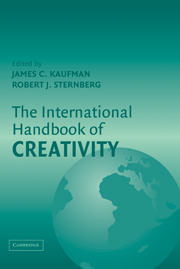Book contents
- Frontmatter
- Contents
- Acknowledgments
- List of Contributors
- 1 Introduction
- 2 Creativity Research in English-Speaking Countries
- 3 Creativity in Latin America
- 4 History of Creativity in Spain
- 5 Past, Present, and Future Perspectives on Creativity in France and French-Speaking Switzerland
- 6 Creativity in Italy
- 7 Creativity Research in German-Speaking Countries
- 8 Creativity Under the Northern Lights
- 9 Creativity in Soviet–Russian Psychology
- 10 Creativity Studies in Poland
- 11 Research on Creativity in Israel
- 12 Creativity in Turkey and Turkish-Speaking Countries
- 13 Development of Creativity Research in Chinese Societies
- 14 Creativity – A Sudden Rising Star in Korea
- 15 Culture and Facets of Creativity
- 16 African Perspectives on Creativity
- 17 Creativity Around the World in 80 Ways … but with One Destination
- Author Index
- Subject Index
- References
4 - History of Creativity in Spain
Published online by Cambridge University Press: 05 June 2012
- Frontmatter
- Contents
- Acknowledgments
- List of Contributors
- 1 Introduction
- 2 Creativity Research in English-Speaking Countries
- 3 Creativity in Latin America
- 4 History of Creativity in Spain
- 5 Past, Present, and Future Perspectives on Creativity in France and French-Speaking Switzerland
- 6 Creativity in Italy
- 7 Creativity Research in German-Speaking Countries
- 8 Creativity Under the Northern Lights
- 9 Creativity in Soviet–Russian Psychology
- 10 Creativity Studies in Poland
- 11 Research on Creativity in Israel
- 12 Creativity in Turkey and Turkish-Speaking Countries
- 13 Development of Creativity Research in Chinese Societies
- 14 Creativity – A Sudden Rising Star in Korea
- 15 Culture and Facets of Creativity
- 16 African Perspectives on Creativity
- 17 Creativity Around the World in 80 Ways … but with One Destination
- Author Index
- Subject Index
- References
Summary
Studies of creativity focusing on education originated in the United States, with the first experimental works dating from the 1950s. Pioneers in the field include Guilford (1950), Osborn (1953), Taylor (1956), Torrance (1962), and Getzels and Jackson (1962). We should also mention the publication in 1883 of Galton's Inquiries into Human Faculty, which had already offered ideas on measuring creativity (Taylor & Barron, 1963) and which gave rise to a great deal of research into creativity and imagination during subsequent decades.
During the 1930s, American psychologists and psychometrics experts prepared a series of tests aimed at measuring originality and its relationship with intelligence. Results, however, showed very little correlation. Subsequent research focused on the creative personality. It was not until 1950, however, that scientific research on creativity gained prominence with Guilford's work on the subject and his 1950 presidential address to the American Psychological Association. Guilford defined creativity as the mental abilities implicit in the creative effort. In his famous model on the structure of intelligence, he defined divergent thought as the capacity to generate information from a given idea or other piece of information, in which the emphasis lies in the variety of responses resulting from the original idea, the product of innovation, originality, an unusual synthesis, or perspective. Divergent thinking includes the factors of fluidity, flexibility, originality, and elaboration. Around 1951, Osborn established the Creative Education Foundation, and two years later he published work on applied imagination and a review of creativity.
- Type
- Chapter
- Information
- The International Handbook of Creativity , pp. 68 - 95Publisher: Cambridge University PressPrint publication year: 2006
References
- 2
- Cited by

